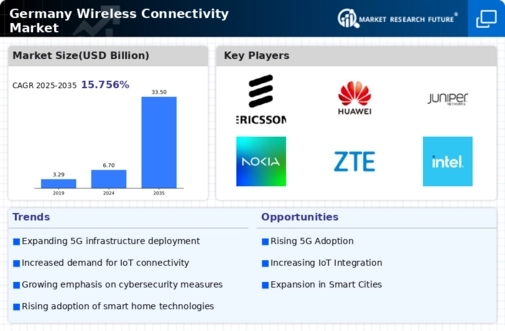Emergence of Smart Cities
The concept of smart cities is gaining traction in Germany, which is likely to have a profound effect on the wireless connectivity market. As urban areas increasingly adopt smart technologies, the demand for reliable and high-speed wireless networks is expected to rise. Initiatives aimed at integrating IoT devices for traffic management, energy efficiency, and public safety are becoming more prevalent. This shift is anticipated to drive investments in the wireless connectivity market, as municipalities seek to enhance their infrastructure to support these innovations. The potential for improved urban living conditions and operational efficiencies may further accelerate the adoption of wireless technologies.
Government Initiatives and Funding
The German government is actively promoting the expansion of the wireless connectivity market through various initiatives and funding programs. With a commitment to digitalization, the government has allocated substantial resources to improve network infrastructure, particularly in rural areas. This includes investments of over €2 billion aimed at enhancing broadband access and promoting 5G deployment. Such initiatives are likely to stimulate growth in the wireless connectivity market, as they encourage private sector participation and innovation. The focus on improving connectivity aligns with Germany's broader economic goals, potentially leading to increased competitiveness and productivity across various sectors.
Rising Demand for High-Speed Internet
The wireless connectivity market in Germany is experiencing a notable surge in demand for high-speed internet services. As more consumers and businesses seek faster and more reliable connections, the market is projected to grow significantly. According to recent data, approximately 80% of households in Germany are now equipped with broadband access, which has led to an increased reliance on wireless technologies. This trend is further fueled by the growing number of smart devices and applications that require robust connectivity. The wireless connectivity market is thus adapting to meet these needs, with investments in infrastructure and technology enhancements becoming essential to support the increasing data traffic.
Increased Consumer Awareness and Adoption
Consumer awareness regarding the benefits of wireless connectivity is on the rise in Germany, which is positively influencing the market. As individuals become more informed about the advantages of wireless technologies, such as flexibility and convenience, the adoption rates are likely to increase. Recent surveys indicate that nearly 70% of consumers prefer wireless solutions for their connectivity needs. This growing preference is prompting service providers to enhance their offerings and invest in better technologies. The wireless connectivity market is thus positioned to benefit from this trend, as increased consumer demand drives innovation and competition among providers.
Growth of Mobile Applications and Services
The proliferation of mobile applications and services is significantly impacting the wireless connectivity market in Germany. As consumers increasingly rely on mobile devices for everyday tasks, the demand for seamless connectivity has intensified. Recent statistics indicate that mobile data traffic in Germany is expected to grow by over 50% in the next few years. This trend is driving investments in wireless infrastructure, as service providers strive to enhance their offerings. The wireless connectivity market is thus witnessing a shift towards more advanced technologies, such as 5G, to accommodate the growing appetite for mobile services and applications, which could reshape consumer behavior and business models.





















Leave a Comment